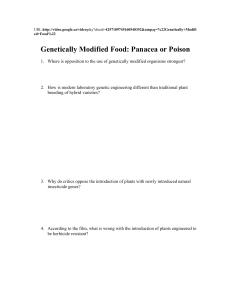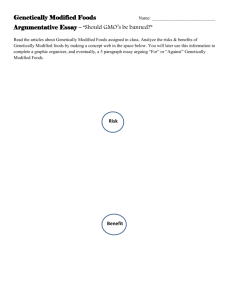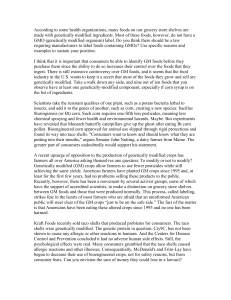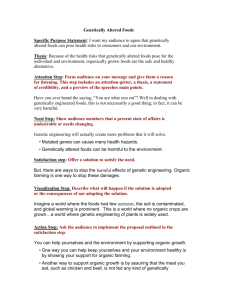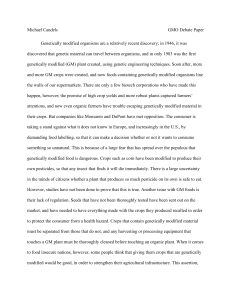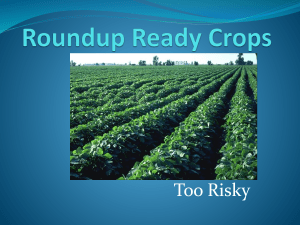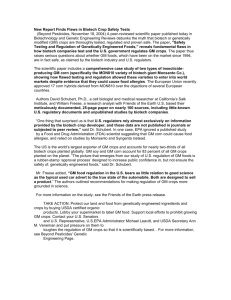GMO - WordPress.com
advertisement
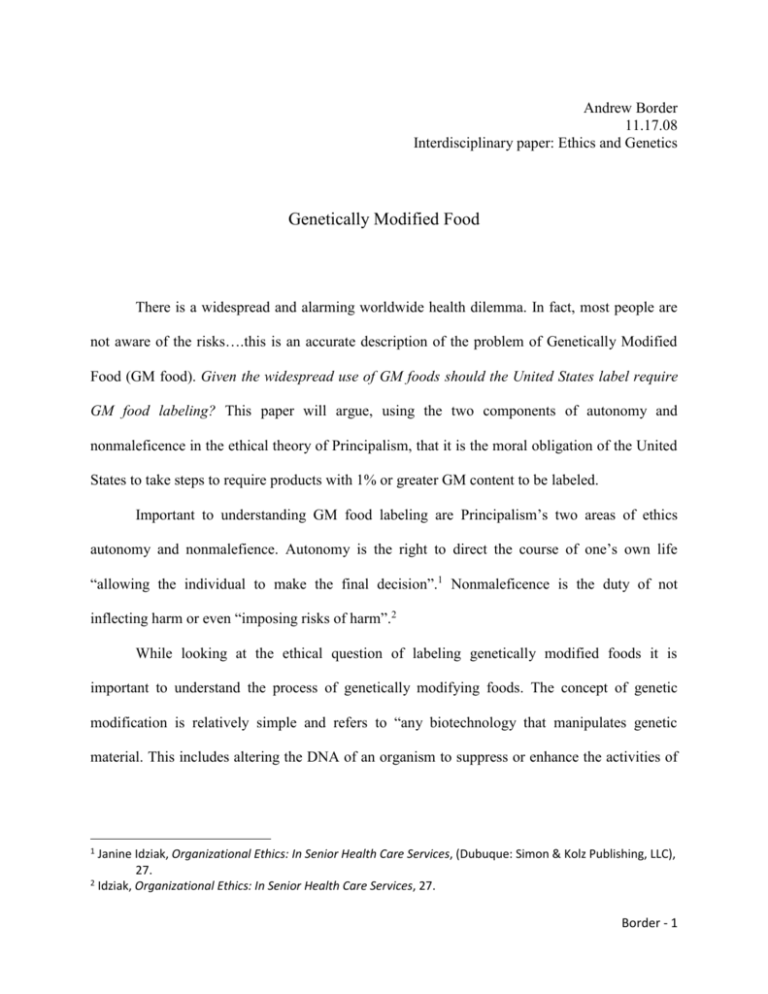
Andrew Border 11.17.08 Interdisciplinary paper: Ethics and Genetics Genetically Modified Food There is a widespread and alarming worldwide health dilemma. In fact, most people are not aware of the risks….this is an accurate description of the problem of Genetically Modified Food (GM food). Given the widespread use of GM foods should the United States label require GM food labeling? This paper will argue, using the two components of autonomy and nonmaleficence in the ethical theory of Principalism, that it is the moral obligation of the United States to take steps to require products with 1% or greater GM content to be labeled. Important to understanding GM food labeling are Principalism’s two areas of ethics autonomy and nonmalefience. Autonomy is the right to direct the course of one’s own life “allowing the individual to make the final decision”.1 Nonmaleficence is the duty of not inflecting harm or even “imposing risks of harm”.2 While looking at the ethical question of labeling genetically modified foods it is important to understand the process of genetically modifying foods. The concept of genetic modification is relatively simple and refers to “any biotechnology that manipulates genetic material. This includes altering the DNA of an organism to suppress or enhance the activities of 1 Janine Idziak, Organizational Ethics: In Senior Health Care Services, (Dubuque: Simon & Kolz Publishing, LLC), 27. 2 Idziak, Organizational Ethics: In Senior Health Care Services, 27. Border - 1 its own genes” or simply transgenetic.3 The process involves first, the DNA being spliced by restnotion so that the gene is to be modified.4 Second, new DNA being placed into the cells and lastly, another enzyme added “to stick the DNA segments together…and the cell begins to carry out the instructions of the new DNA along with its own”.5 One of the main types of modification involves enhancing the Bacillus thuringiensis (Bt) gene in plants. Bt when enhanced acts as a more potent natural insecticide, however in order for the insect to activate the insecticide they must attempt to eat the plant. Thus is still very safe and edible to human consumption, in 2003 “25 per cent of the field corn grown used Bt plant technology”.6 The problem with GM food is that potentially unrelated genes are added from organisms into various plants. This fear comes from the fact that genetic modification is very different than traditional genetic cross breeding that has been going on for thousands of years. An example of this would be a pesticide chemical being added into the cells of corn to make them resistant to herbicide such as in the case with Roundup Ready © corn. The regulatory need for genetic labeling in food will be looked at through the specific examples of corn and soy. The United States is the world’s leading producer of corn and it was estimated that by 2000, 25% of the corn crop was genetically modified. 7 Well over half of the 3 Ricki Lewis, Human Genetics: Concepts and Applications, (New York: McGraw-Hill Higher Education, 2008), 376. 4 Cartage.org, “How Genetic Modification Works”, http://www.cartage.org.lb/en/themes/Sciences/Lifescience/PhysicalAnthropology/HeredityBeyond/ ManipulatingDNA/GeneticEngineering/Works/Works.htm, (accessed October 25, 2009). 5 Cartage.org, “How Genetic Modification Works”. 6 Anthony Shelton, “Considerations of the use of Transgenic Crops for Insect Control”, Journal of Developmental Studies 43, 5, (2007), 893. 7 TLC Cooking, “5 Common Genetically Modified Foods”, http://recipes.howstuffworks.com/5-commongenetically-modified-foods1.htm, (accessed October 25, 2009). Border - 2 world’s soy market is genetically modified.8 The leading genetically modified variety of corn and soy that we will be examining is Roundup Ready © corn and Roundup Ready © soy, which is manufactured by the Monsanto corporation beginning in the late 1990s. Monsanto has been in existence since 1901when it first produced sugar substitutes.9 In 1987 the Federal government allowed the corporation to grow modified Roundup Ready tomatoes.10 The Monsanto company website however fails to mention Monsanto’s involvement with military defense contracting. Monsanto was the largest supplier of Agent Orange during the Vietnam War.11 Interestingly, “internal memos show that Monsanto knew of the problems of dioxin contamination of Agent Orange when it sold it to the U.S. government for use in Vietnam”.12 Besides being allowed to grow Roundup Ready tomatoes, Monsanto paid over $180 million dollars to Vietnam veterans. The Monsanto machine today controls “almost 90% of the total world area devoted to GM seeds”.13 Persons against the labeling of GM foods argue that autonomy will be negatively affected. America is a capitalist nation, capitalism at its heart is autonomy, and corporations such as Monsanto are in principal given laissez fair to operate freely as to generate capitol. Furthermore, “the major GM crop varieties have been available in the United States for six years, long enough for farmers to make their own judgments”.14 Some farmers even like the ‘terminator 8 TLC Cooking, “5 Common Genetically Modified Foods”. Monsanto.com, “Monsanto Our Fertile History”, http://www.monsanto.com/who_we_are/history.asp, (accessed November 11, 2009). 10 Monsanto.com, “Monsanto Our Fertile History”. 11 gmwatch.org. “Monsanto – A History”. http://www.gmwatch.org/gm-firms-org/10595-monsanto-ahistory, (accessed November 11, 2009). 9 12 gmwatch.org. “Monsanto – A History”. gmwatch.org. “Monsanto – A History”. 14 The Irish Council for Bioethics, Genetically modified crops and food: threat or opportunity for Ireland?, 13 Border - 3 technology’ because it requires them to keep a strong GM crop, therefore eliminating potential viruses.15 However, implementing a labeling system for genetically modified food is supported by the principal of autonomy. Many organizations Consumers overwhelming favor the labeling of GM foods (74%).16 A more recent statistic from 2007, points to the number of consumers favoring labeling GM foods to be even higher (90%).17 Disheartening is the fact that only 19% of Americans believe that they have eaten GM food, essentially proving the lack of education and consumer awareness as well as the inherent lack of autonomy that would accompany.18 It is statistically obvious that consumers would like transparency in knowing what they are eating and also obvious that they are not aware of what they are eating. World governments understand this transcultural need for autonomy in regards to our food supply and are leaps ahead of the United States in requiring genetic labeling. World governments understand the importance of labeling genetically modified food. This concept by the European Union (EU), for example, reqiring that any material over 1% GM modified must be labeled. In this case, the EU is allowing for the chances of minor accidental contamination and gives understanding liberality to products that have the intent of not being GM modified.19 In addition the European Union in 2001 amended their policy “reinforcing current labeling rules and streamlining the authorization procedure for GMOs in food and feed and for their deliberate Opinion: 2005, 86. The Irish Council for Bioethics, Genetically modified crops and food: threat or opportunity for Ireland?, Opinion: 2005, 86. 16 Britt Bailey and Marc Lappe, Engineering the Farm: Ethical and Social Aspects of Agricultural Biotechnology (Washington: Island Press, 2002), 101. 17 Pamela Drew, Roundup Ready Nation Dying for Profits, 2007. 18 Pamela Drew, Roundup Ready Nation Dying for Profits. 19 Britt Bailey and Marc Lappe, Engineering the Farm: Ethical and Social Aspects of Agricultural Biotechnology, 16. 15 Border - 4 release into the environment”.20 There are other countries that have similar GM labeling laws. These other countries include Japan, South Korea, Australia and New Zealand.21 Another governmental organization is the Irish Council on Bioethics. The Irish Council on Bioethics is an independent body of scientists, political leaders and business people. This Council completed in 2005 a careful study on the effects of allowing GM food into Ireland. One of their principles in decision making was autonomy. The Irish Council stated: “The right to abstain from using and consuming GMOs should be protected for each individual within reasonable limits. However, this right should not be extended to impose particular views on the general public and must not be to the detriment to others”.22 Thus, according to the Irish Council on Bioethics, the genetic labeling of food would be supported in that consumers should have the protected right of being “GM free”. Some people argue that consuming GM foods is not harmful. For instance they point to the success of modified Bt. Bt “appears to have little impact on the general environment”.23 Also, there is no reported occurrence of harm to humans after long-term Bt use.24 Several rice fields in China recently adopted Bt rice, creating a nine percent increase of produce, while reducing 20 The Irish Council for Bioethics, Genetically modified crops and food: threat or opportunity for Ireland?, Opinion: 2005, 25. 21 Britt Bailey and Marc Lappe, Engineering the Farm: Ethical and Social Aspects of Agricultural Biotechnology, 16. 22 The Irish Council for Bioethics, Genetically modified crops and food: threat or opportunity for Ireland?, Opinion: 2005, 25. 23 Anthony Shelton, “Considerations of the use of Transgenic Crops for Insect Control”, Journal of Developmental Studies 43, 5, (2007), 893. 24 Anthony Shelton, “Considerations of the use of Transgenic Crops for Insect Control”, Journal of Developmental Studies 43, 5, (2007), 895. Border - 5 insecticide spray.25 Since, Bt does not have documented effects against humans these people would argue that labeling GM foods is unnecessary and therefore just an added cost to American business. Supports will also state that GM technology is completely safe. Supporting this claim they point to the risk of allergies staying, “the possibility of creating new allergens has been identified as a risk that does not relate directly to the use of GM technology, but depends on the particular gene that has been added to a GM crop”.26 Therefore, GM foods safety is a non issue when “every new crop is evaluated on a case-by-case basis”.27 Lastly, the United Nations trusts GM food and therefore “Roundup Ready corn is a safe and nutritious as conventional varieties of corn on the market”.28 These supporters would claim that since there is scientific testing done, the risk of allegiance is minimal, and thus not a reason for labeling. However, nonmaleficence, another ethical principle of Principalism is the basic premise that human life should never be harmed or even threatened with harm. The health and safety of the long term consumption of GM foods is one of the top concerns with even producing GM foods. Scientists have discovered a potential hazard in that “Roundup Ready soybeans may display an increase in anti-nutrients (possible cancer causing cells). These anti-nutrients were found to cause infertility problems in sheep and cattle as well as allergic reactions”. 29 Antinutrients In fact, the birthrates of piglets fell (spontaneous abortions) 80% when fed strictly with 25 Anthony Shelton, “Considerations of the use of Transgenic Crops for Insect Control”, Journal of Developmental Studies 43, 5, (2007), 898. 26 The Irish Council for Bioethics, Genetically modified crops and food: threat or opportunity for Ireland?,17. 27 The Irish Council for Bioethics, Genetically modified crops and food: threat or opportunity for Ireland?, 17. 28 The Irish Council for Bioethics, Genetically modified crops and food: threat or opportunity for Ireland?, 17. 29 Dona Artemis and Ioannis Arvanitoyannis, “Health Risks of Genetically Modified Foods”, Critical Reviews in Food Science and Nutrition 49: 154-175, 2009, 165. Border - 6 GM corn.30 This dangerous anti-nutrient is especially dangerous because of the heightened risk when ingesting the GM food before processing.31 Clearly, expecting mothers would like to know if what they are doing is safe for their baby, much like how alcohol carries a warning to women who are pregnant to discourage fetal alcohol syndrome. This same study pointed at “potentially harmful immunological responses including allergic hypersensitivity” relating to Round Up Ready corn.32 This increase in allergic sensitivity is of concern because one out of seventeen children under the age of three has a food allergy.33 Most significantly, scientific testing has indicated not only a 56% death rate in rats feed with GM soy, but one study done in Europe clams that “many GM foods have common side effects”.34 Therefore, should one assume that spontaneous abortions, development towards allergic reactions and even death are common? Someone pausing to contemplate this question already agrees with the point that Genetically Modified foods should be regulated from the perspective of nonmaleficence because there should not be a risk towards any human life. Analogically, to heavily regulated pharmaceuticals, “it has been argued that GM foods should be subjected to the same testing and approval procedures as medicines since they must be adequate to ensure that any possibility of an adverse effect on human health from a GM food can be detected”.35 The Food and Drug Administration (FDA) does not require human clinical trials, instead the companies decide at their own judgment if a food is acceptable to the general public.36 This proves the lack of regulation and dangerousness of the GM industry. While pharmaceuticals which chemically change our body are forced to 30 Dona Artemis and Ioannis Arvanitoyannis, “Health Risks of Genetically Modified Foods”, 170. Dona Artemis and Ioannis Arvanitoyannis, “Health Risks of Genetically Modified Foods”, 165. 32 Dona Artemis and Ioannis Arvanitoyannis, “Health Risks of Genetically Modified Foods”, 168. 33 Pamela Drew, Roundup Ready Nation Dying for Profits. 34 Dona Artemis and Ioannis Arvanitoyannis, “Health Risks of Genetically Modified Foods”, 172. 35 Dona Artemis and Ioannis Arvanitoyannis, “Health Risks of Genetically Modified Foods, 165. 36 Pamela Drew, Roundup Ready Nation Dying for Profits. 31 Border - 7 meet ethical standards of nonmaleficenc, Genetically Modified foods, which also enter our body, are not required to meet these same ethical humane standards. What is more comical is that GM companies such as Monsanto portray themselves as humanitarian organizations trying to feed the world. Genetic engineering cannot solve world hunger “increases in food production may temporarily alleviate the problem, but it is mathematically certain that they cannot be a long-term solution”.37 The United States consumes a wide range of GM foods, “yet many people still suffer from hunger in the United States, despite agricultural surpluses”.38 Monsanto’s Roundup Ready sweet potato envisioned to help third world hunger in Kenya was shown to be vulnerable to crop failure. A Kenyan newspaper announced that, “trials to develop a virus resistant sweet potato through biotechnology have failed. US biotechnology, imported three years ago, has failed to improve Kenya's sweet potato”.39 Adding to the pressing concern over nonmalefiance, The Irish Council for Bioethics in regards to ethical development in GM crops stated, “decisions about the development and implication of GM crop techniques should depend on their overall impact on general welfare, measured through some system of cost-benefit analysis”.40 Monsanto is not studying these long term implications of the new ‘species of plant’ that are hatching in laboratories. Monsanto does not want people to think of the 1999 finding that GM corn could potentially harm the monarch 37 Anthony Shelton, “Considerations of the use of Transgenic Crops for Insect Control”, Journal of Developmental Studies 43, 5, (2007), 898. 38 Anthony Shelton, “Considerations of the use of Transgenic Crops for Insect Control”, Journal of Developmental Studies 43, 5, (2007), 898. 39gmwatch.org, “millions served”, http://www.gmwatch.org/gm-myths/11132-qmillions-servedq-the-gmsweet-potato, (accessed November 11, 2009). 40 The Irish Council for Bioethics, Genetically modified crops and food: threat or opportunity for Ireland?, 11. Border - 8 butterfly (an endangered species).41 Since the scientific community still does not understand how genetics works more caution such as by labeling should be exercised by corporations. Monsanto as well as other GM companies cannot be trusted to follow the principal of nonmalefiance because “companies generally do not send complete studies they perform to regulatory agencies in the United States, only summaries. Nor do they publish their findings in mainstream scientific journals”.42 For the sake of our community, genetic labeling is necessary. The documentary Roundup Ready Nation, Dying for Profits mentioned a study done showed that of 20,000 “traditional seeds” or non-GM seeds (80% from organic farms), roughly 50% of the organic seeds were found to test positive to GM.43 While there is a claim that GM foods are safe as conventional foods and should not be labeled this clam is not valid. While demonstrating “that GM technology appears to ‘work’ is short sighted if the longer-term consequences and ripple effects of the technology are ignored”.44 The infamous 2000Starlink corn scandal exposed this potential problem of allergic reactions from consuming GM foods.45 Most importantly Genetically Modified foods should be labeled because conventional crops should be valued in that they are “guaranteed free of genetically engineered material”.46 41 The Irish Council for Bioethics, Genetically modified crops and food: threat or opportunity for Ireland?, 22. Richard Caplan, “Ensuring the Public’s Right to Safe Food”, Why We Need A Genetic Bill of Rights: Rights and Liberties in the Biotech Age, New York: Rowman & Littlefield Publishers, 2005, 80. 43 Pamela Drew, Roundup Ready Nation Dying for Profits. 44 Richard Caplan, “Ensuring the Public’s Right to Safe Food”, Why We Need A Genetic Bill of Rights: Rights and Liberties in the Biotech Age, 58. 45 Anthony Shelton, “Considerations of the use of Transgenic Crops for Insect Control”, Journal of Developmental Studies 43, 5, (2007), 893. 46 Richard Caplan, “Ensuring the Public’s Right to Safe Food”, Why We Need A Genetic Bill of Rights: Rights and Liberties in the Biotech Age, 58. 42 Border - 9 Where does the United States farmer stand in this argument? The United States farmer is more radical when it comes to the principal of autonomy. 82% of farmers surveyed from the American Corn Growers Association believe that it is a country’s right to refuse GM foods. 47 In Iowa alone there are over 13,775 Monsanto GM field test sites. 48 However, a farmer using Monsanto’s GM modified seeds are bound by legal gag orders to not talk or voice any concern about how their product should be marketed.49 Through the application of Principalism along with the case examples of Roundup Ready © corn and soy, it is easy to conclude that Genetically Modified food should have labeling. Given the risks of allergies, miscarriage and other ailments largely unknown because of the short history of GM usage, labeling is the least our government can do to protect the right of consumers to be GM free. Labeling GM modified foods will also protect the rights of society’s most fragile members, that is, people with low-incomes, who often do not have the ability to purchase quality foods and are more likely to purchase GM brand foods. 47Pamela Drew, Roundup Ready Nation Dying for Profits. Pamela Drew, Roundup Ready Nation Dying for Profits. 49 Pamela Drew, Roundup Ready Nation Dying for Profits. 48 Border - 10 Works Cited Artemis, Dona and Ioannis Arvanitoyannis. “Health Risks of Genetically Modified Foods”. Critical Reviews in Food Science and Nutrition 49: 154-175, 2009. Bailey, Britt and Marc Lappe. Engineering the Farm: Ethical and Social Aspects of Agricultural Biotechnology. Washington: Island Press, 2002. Cartage.org. “How Genetic Modification Works”. http://www.cartage.org.lb/en/themes/Sciences/Lifescience/PhysicalAnthropology/Heredit yBeyond/ManipulatingDNA/GeneticEngineering/Works/Works.htm, (accessed October 25, 2009). Caplan, Richard. “Ensuring the Public’s Right to Safe Food”. Why We Need A Genetic Bill of Rights: Rights and Liberties in the Biotech Age. New York: Rowman & Littlefield Publishers, 2005. Drew, Pamela. Roundup Ready Nation Dying for Profits. 2007. Gmwatch.org. “GM Watch”. http://www.gmwatch.org/ (accessed November 11, 2009). Idziak, Janine. Organizational Ethics: In Senior Health Care Services. Dubuque: Simon & Kolz Publishing, LLC. Lewis, Ricki. Human Genetics: Concepts and Applications. New York: McGraw-Hill Higher Education, 2008. Monsanto.com. “Monsanto Our Firtile History”. http://www.monsanto.com/who_we_are/history.asp, (accessed November 11, 2009). Shelton, Anthony. “Considerations on the use of Transgenic crops for Insect Control”. Journal of Developmental Studies 43, 5 (2007). The Irish Council for Bioethics. Genetically modified crops and food: threat or opportunity for Ireland? Opinion: 2005. TLC Cooking. “5 Common Genetically Modified Foods”. http://recipes.howstuffworks.com/5-common-genetically-modified-foods1.htm. (accessed October 25, 2009). Border - 11
